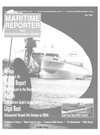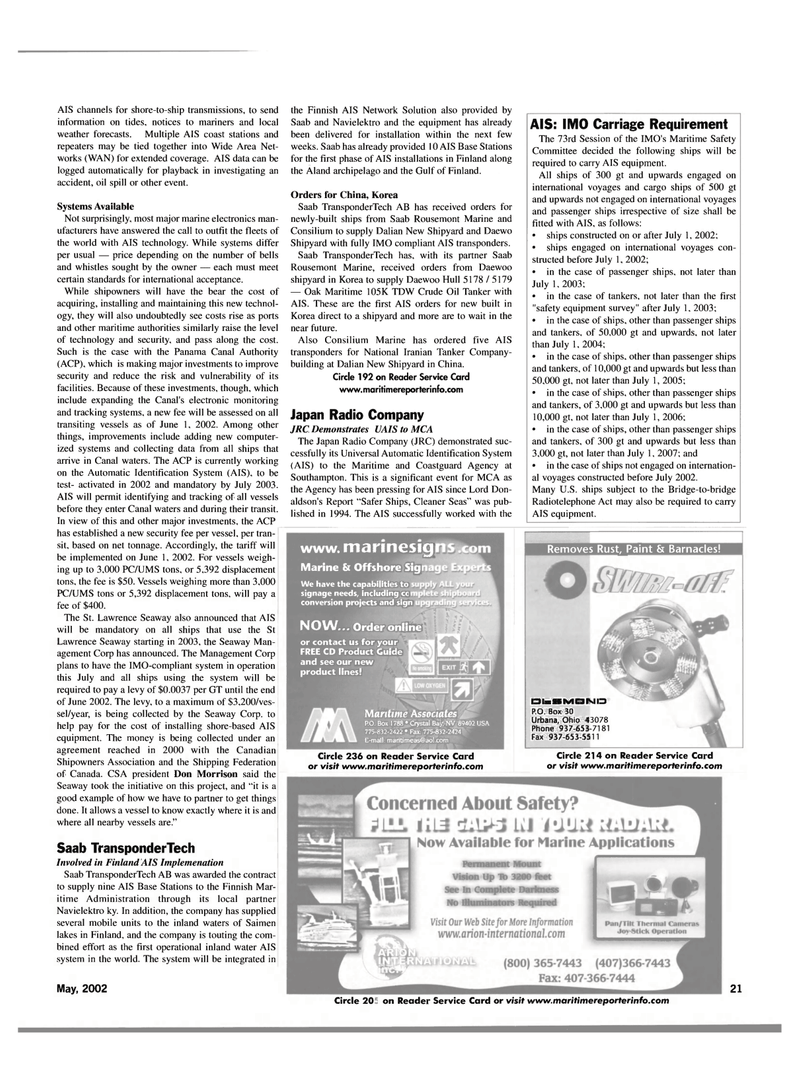
Page 21: of Maritime Reporter Magazine (May 2002)
Read this page in Pdf, Flash or Html5 edition of May 2002 Maritime Reporter Magazine
AIS channels for shore-to-ship transmissions, to send information on tides, notices to mariners and local weather forecasts. Multiple AIS coast stations and repeaters may be tied together into Wide Area Net- works (WAN) for extended coverage. AIS data can be logged automatically for playback in investigating an accident, oil spill or other event.
Systems Available
Not surprisingly, most major marine electronics man- ufacturers have answered the call to outfit the fleets of the world with AIS technology. While systems differ per usual — price depending on the number of bells and whistles sought by the owner — each must meet certain standards for international acceptance.
While shipowners will have the bear the cost of acquiring, installing and maintaining this new technol- ogy, they will also undoubtedly see costs rise as ports and other maritime authorities similarly raise the level of technology and security, and pass along the cost.
Such is the case with the Panama Canal Authority (ACP), which is making major investments to improve security and reduce the risk and vulnerability of its facilities. Because of these investments, though, which include expanding the Canal's electronic monitoring and tracking systems, a new fee will be assessed on all transiting vessels as of June 1, 2002. Among other things, improvements include adding new computer- ized systems and collecting data from all ships that arrive in Canal waters. The ACP is currently working on the Automatic Identification System (AIS), to be test- activated in 2002 and mandatory by July 2003.
AIS will permit identifying and tracking of all vessels before they enter Canal waters and during their transit.
In view of this and other major investments, the ACP has established a new security fee per vessel, per tran- sit, based on net tonnage. Accordingly, the tariff will be implemented on June 1, 2002. For vessels weigh- ing up to 3,000 PC/UMS tons, or 5,392 displacement tons, the fee is $50. Vessels weighing more than 3,000
PC/UMS tons or 5,392 displacement tons, will pay a fee of $400.
The St. Lawrence Seaway also announced that AIS will be mandatory on all ships that use the St
Lawrence Seaway starting in 2003, the Seaway Man- agement Corp has announced. The Management Corp plans to have the IMO-compliant system in operation this July and all ships using the system will be required to pay a levy of $0.0037 per GT until the end of June 2002. The levy, to a maximum of $3,200/ves- sel/year, is being collected by the Seaway Corp. to help pay for the cost of installing shore-based AIS equipment. The money is being collected under an agreement reached in 2000 with the Canadian
Shipowners Association and the Shipping Federation of Canada. CSA president Don Morrison said the
Seaway took the initiative on this project, and "it is a good example of how we have to partner to get things done. It allows a vessel to know exactly where it is and where all nearby vessels are."
Saab TransponderTech
Involved in Finland AIS Implemenation
Saab TransponderTech AB was awarded the contract to supply nine AIS Base Stations to the Finnish Mar- itime Administration through its local partner
Navielektro ky. In addition, the company has supplied several mobile units to the inland waters of Saimen lakes in Finland, and the company is touting the com- bined effort as the first operational inland water AIS system in the world. The system will be integrated in
May, 2002 the Finnish AIS Network Solution also provided by
Saab and Navielektro and the equipment has already been delivered for installation within the next few weeks. Saab has already provided 10 AIS Base Stations for the first phase of AIS installations in Finland along the Aland archipelago and the Gulf of Finland.
Orders for China, Korea
Saab TransponderTech AB has received orders for newly-built ships from Saab Rousemont Marine and
Consilium to supply Dalian New Shipyard and Daewo
Shipyard with fully IMO compliant AIS transponders.
Saab TransponderTech has, with its partner Saab
Rousemont Marine, received orders from Daewoo shipyard in Korea to supply Daewoo Hull 5178 / 5179 — Oak Maritime 105K TDW Crude Oil Tanker with
AIS. These are the first AIS orders for new built in
Korea direct to a shipyard and more are to wait in the near future.
Also Consilium Marine has ordered five AIS transponders for National Iranian Tanker Company- building at Dalian New Shipyard in China.
Circle 192 on Reader Service Card www.maritimereporterinfo.com
Japan Radio Company
JRC Demonstrates UAIS to MCA
The Japan Radio Company (JRC) demonstrated suc- cessfully its Universal Automatic Identification System (AIS) to the Maritime and Coastguard Agency at
Southampton. This is a significant event for MCA as the Agency has been pressing for AIS since Lord Don- aldson's Report "Safer Ships, Cleaner Seas" was pub- lished in 1994. The AIS successfully worked with the www. marinesig
Marine & Offshore Sig
We have the capabilities to signage needs, including cc conversion projects and sign
NOW.. . Order online or contact us for your
FREE CD Product Guide and see our new product lines!
Maritime Associates
P.O. Box 1788 • Crystal Ba^NV 89402 USA 775-832-2425 • Fax: i775-832-2'&
E-mail: [email protected]
Circle 236 on Reader Service Card or visit www.maritimereporterinfo.com
AIS: IMO Carriage Requirement
The 73rd Session of the IMO's Maritime Safety
Committee decided the following ships will be required to carry AIS equipment.
All ships of 300 gt and upwards engaged on international voyages and cargo ships of 500 gt and upwards not engaged on international voyages and passenger ships irrespective of size shall be fitted with AIS, as follows: • ships constructed on or after July 1, 2002; • ships engaged on international voyages con- structed before July 1, 2002; • in the case of passenger ships, not later than
July 1, 2003; • in the case of tankers, not later than the first "safety equipment survey" after July 1, 2003; • in the case of ships, other than passenger ships and tankers, of 50,000 gt and upwards, not later than July 1, 2004; • in the case of ships, other than passenger ships and tankers, of 10,000 gt and upwards but less than 50,000 gt, not later than July 1, 2005; • in the case of ships, other than passenger ships and tankers, of 3,000 gt and upwards but less than 10,000 gt, not later than July 1, 2006; • in the case of ships, other than passenger ships and tankers, of 300 gt and upwards but less than 3,000 gt, not later than July 1, 2007; and • in the case of ships not engaged on internation- al voyages constructed before July 2002.
Many U.S. ships subject to the Bridge-to-bridge
Radiotelephone Act may also be required to carry
AIS equipment.
Removes Rust, Paint & Barnacles!
Circle 214 on Reader Service Card or visit www.maritimereporterinfo.com 21
Circle 201 on Reader Service Card or visit www.maritimereporterinfo.com
D1= E5IVIC3MO
P.O. Box 30
Urbana, Ohio 43078
Phone 937-653-7181
Fax 937-653-5511

 20
20

 22
22
